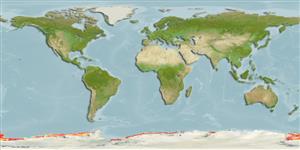Environment: milieu / climate zone / depth range / distribution range
Écologie
marin bathydémersal; profondeur 450 - 2100 m. Deep-water; 68°S - 79°S
Southern Ocean: Antarctic continental shelf and slopes. Probably circum-Antarctic.
Taille / Poids / Âge
Maturity: Lm ? range ? - ? cm
Max length : 25.0 cm SL mâle / non sexé; (Ref. 5192)
Found at depths ranging between 450-950 m and 1,750-2,100 m. The discontinuity may be due to inadequate sampling.
Life cycle and mating behavior
Maturities | Reproduction | Spawnings | Egg(s) | Fecundities | Larves
Gon, O., 1990. Bathydraconidae. p. 364-380. In O. Gon and P.C. Heemstra (eds.) Fishes of the Southern Ocean. J.L.B. Smith Institute of Ichthyology, Grahamstown, South Africa. 462 p. (Ref. 5192)
Statut dans la liste rouge de l'IUCN (Ref. 130435)
Menace pour l'homme
Harmless
Utilisations par l'homme
Pêcheries: sans intérêt
Outils
Articles particuliers
Télécharger en XML
Sources Internet
Estimates based on models
Preferred temperature (Ref.
123201): -1.9 - 1.2, mean 0.4 °C (based on 303 cells).
Phylogenetic diversity index (Ref.
82804): PD
50 = 0.5313 [Uniqueness, from 0.5 = low to 2.0 = high].
Bayesian length-weight: a=0.00224 (0.00117 - 0.00427), b=3.25 (3.07 - 3.43), in cm total length, based on LWR estimates for this (Sub)family-body shape (Ref.
93245).
Niveau trophique (Ref.
69278): 3.6 ±0.4 se; based on size and trophs of closest relatives
Résilience (Ref.
120179): Milieu, temps minimum de doublement de population : 1,4 à 4,4 années (Preliminary K or Fecundity.).
Fishing Vulnerability (Ref.
59153): Low vulnerability (21 of 100).
